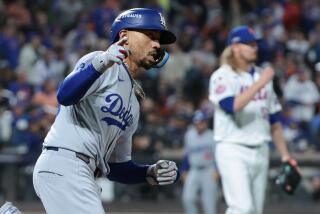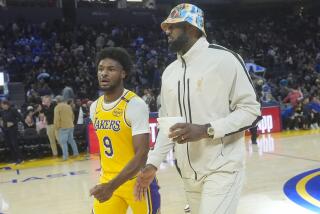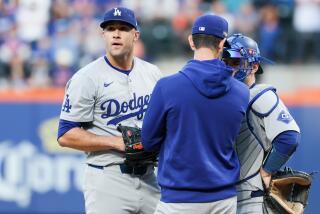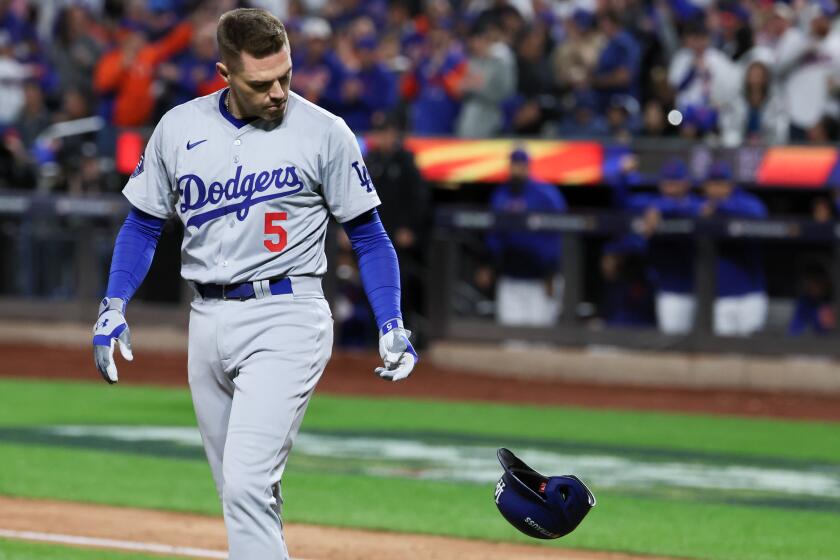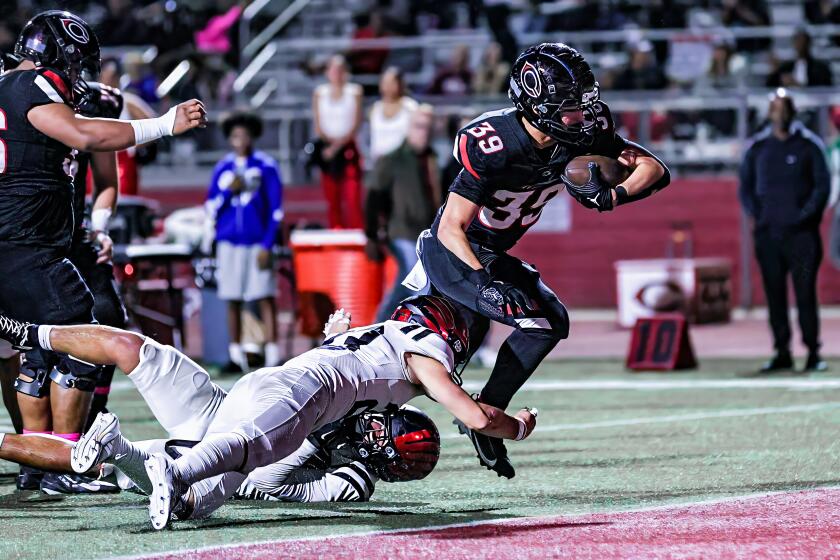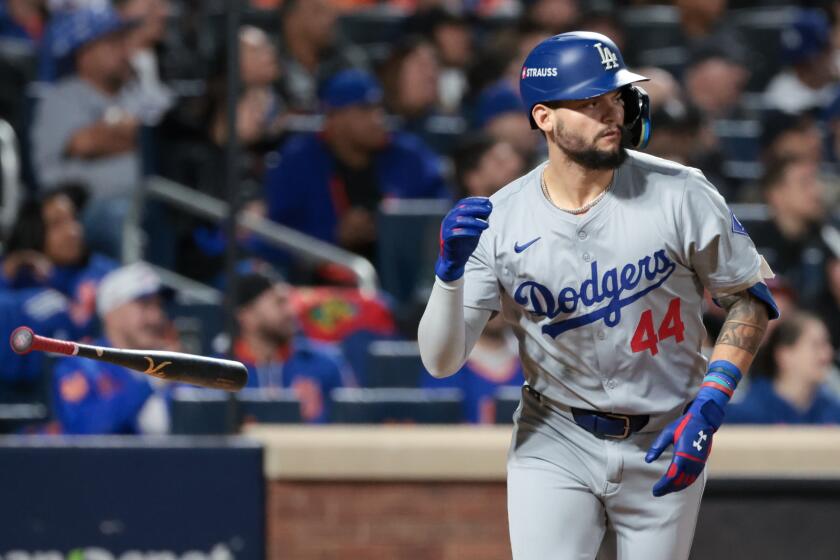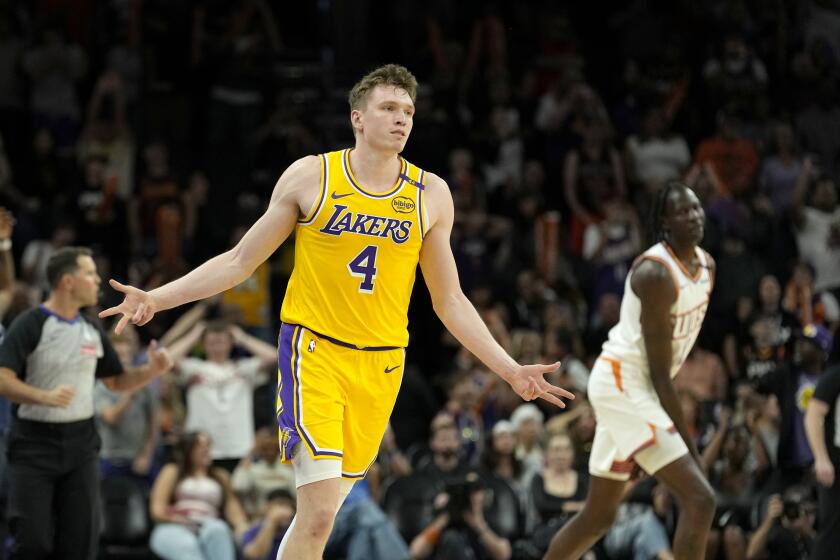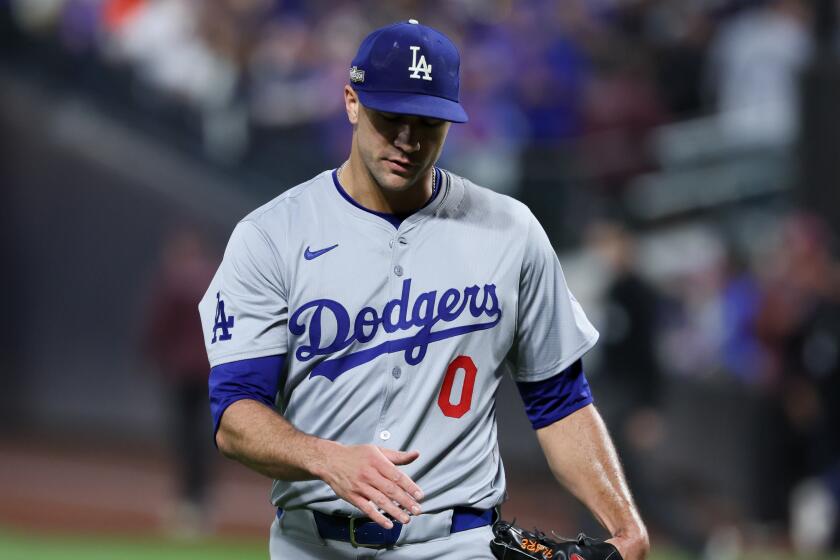Right Up His Alley
It was 50 years ago that Ben Hogan won the Masters, U.S. Open and British Open -- three parts of golf’s Grand Slam -- and perhaps missed the PGA Championship only because its date overlapped with the British Open, which he won at Carnoustie in his only appearance.
Hogan won tournaments around the world, lived in Fort Worth and for most his career represented Hershey, Pa., on the PGA Tour, but the late-blooming success in his legendary career was forged in Southern California.
It was here, in 1932, that he played in his first professional tournament, the Los Angeles Open at Hillcrest. It was here, in 1948, that he won his first U.S. Open, at Riviera. That was his third tournament victory there in 18 months and gave the course its reputation as “Hogan’s Alley.”
It was here, in 1949, in the Long Beach Open at Lakewood, that he beat his close friend, Jimmy Demaret, in a playoff and decided it was time to relax and head home to Texas. It was on that trip, after stopping in Phoenix for another tournament in which he and Demaret faced each other in another playoff, that he nearly lost his life on a foggy highway west of Van Horn, Texas, when a bus hit his car head-on.
Hogan, who reacted by diving across the seat to protect his wife, Valerie, suffered a broken collarbone, smashed rib, double fracture of the pelvis and a broken ankle. His act of heroism to save his wife probably saved his life. The impact of the 10-ton bus drove the steering wheel into the back seat.
Later, Hogan developed a blood clot that caused doctors to tie off the principal vein in his legs, forcing him to wear elastic bandages.
It was widely believed that Hogan would never play golf again.
Yet, 13 months later, Hogan was back at Riviera making the most dramatic comeback in golf history to play in the 1950 L.A. Open and finish tied with Sam Snead.
“1950 wasn’t a month old and the comeback of the year had been decided,” golf columnist Dick Taylor wrote.
It was a bit anticlimactic when, eight days later because of rain delays, Snead beat Hogan in a playoff.
When rumors floated out of Fort Worth that Hogan was thinking about coming to Riviera, L.A. Open committeemen hastily invited him to be the tournament’s honorary starter.
“Honorary starter, hell,” he replied. “If I go out there, I’m going to play.”
It was considered so unlikely that his name did not appear in the 1950 L.A. Open Press & Radio Guide.
Typically, Hogan wanted no attention. He demanded that no photographers follow him around and he told announcer Scotty Chisholm, a big kilts-wearing Scotsman with a booming voice, “Just introduce me like you usually would. I don’t want any special attention from the gallery.”
Special attention was paid, however, when he shot 73-69-69-69 -- 280, four under for par-71 Riviera. It took birdies on the final two holes for Snead to catch him.
The 18-hole playoff, in the days before TV-inspired sudden-death finishes, was delayed two days by rain and flooding, followed by the Crosby Pro-Am, a travel day on Monday and Tuesday was out because it was Ladies Day at the course.
When the playoff finally started, on a foggy Wednesday, Hogan hit his first tee shot out of bounds into the polo field left of the first fairway. He fell behind and never caught Snead, losing, 76 to 72. Hogan didn’t make a birdie all day.
It was the last time he played a competitive round at Riviera, a course he later told golf writer Dan Jenkins was “One of my favorites, before the flood.”
The flood ripped raw gashes in Santa Monica canyon, digging even deeper the barrancas that criss-crossed the course to give it its character. Riviera is a much different course today, its barrancas gone with the coming of underground storm drains and its fairways scarred with cart paths.
There were none in Hogan’s day because there were no carts. It was walk or don’t play.
A taciturn, some say dour, man, Hogan never acknowledged great shots by tipping his cap, a flat, white-linen trademark. He hated post-round interviews in which writers who had not walked the course (there was no television then) would ask him to go through his round, shot by shot.
One day, he was so exasperated that he said, “One day a deaf mute will win a tournament and you guys won’t be able to write a word.”
The white cap wasn’t Hogan’s only trademark. He perpetually had a cigarette dangling from his lips, often even while putting.
The 1948 U.S. Open was the first held on the West Coast and at 7,202 yards, Riviera was the longest course to date.
It didn’t matter to Hogan, then 36, who approached it with such confidence that he hired Virgil Caywood, a teenager who worked weekends as a caddie, to carry his clubs all week. He shot 67-72-68-69 -- 276 to break the tournament record by five shots. Demaret broke the old record by three and Jim Turnesa by one. Hogan won $2,000.
Before 1965 and the arrival of televised golf, all U.S. Opens ended with 36 holes on the final day. Hogan started the morning round a shot behind Snead, but after a 68, he led by two going into the afternoon’s final 18. Wasting no time, he went out in 33, finished with 69 and a two-shot margin over Demaret.
The tournament was unusual in that Ted Rhodes played, the first black player in a U.S. Open.
It was also unusual in that it was a financial flop because of small crowds. Critics pointed to the high price of admission, $3 for each of the first two days and $4 for the 36-hole final day.
Hogan played in 11 L.A. Opens, winning three of them, 1942, 1947 and 1948, and losing one in a playoff, 1950.
His first win, at Hillcrest, was helped by Snead’s collapse on 18, when he took a triple-bogey eight. A par would have won the tournament. Hogan finished in a tie with Jimmy Thomson and won the playoff and its $3,500 prize.
At one point while playing with Lloyd Mangrum on the final day, Hogan’s ball rolled into a gopher hole. Hogan wanted a ruling, but when no official showed up, Mangrum said, “You hit it in there, hit it out.”
An infuriated Hogan smashed it with such force that it took out six inches of dirt, broke his club ... and ended up on the green.
The year before, playing at Riviera for the first time, Hogan tied for third behind Johnny Bulla, who started the tournament with seven consecutive threes.
In his first Southland tournament, the 1932 L.A. Open at Hillcrest, Hogan finished tied for 17th, then played in the Agua Caliente Open in Tijuana and collected $200 for finishing tied for 15th.
It wasn’t for another six years, while he worked to earn enough money to try the tour again, that he showed up in Los Angeles. Still on a shoestring, he didn’t make any money with a 53rd in the L.A. Open, but after tying for 10th in the Pasadena Open -- played at Pasadena Municipal, now Brookside -- he and Valerie decided they had just enough to try one more tournament before quitting again.
Up to Oakland they went and when Hogan won $285, he called it “the biggest check I’d ever seen in my life.” It was also the last time he came close to calling it a career because of lack of money.
In addition to the L.A. Opens, Hogan won a Glendale Open in 1948 at Oakmont and the Long Beach Open in 1949.
It was at Lakewood that he demonstrated his capacity for executing a plan that didn’t conform to the norm.
The 17th hole at Lakewood, a 220-yard par three, sat on the side of a slope with a trap on the left side. Four times, including in the playoff with Demaret, Hogan hit tee shots into the bunker and each time got up and down for par.
Asked why he always seemed to be in that trap, Hogan said, “I aim for it; it’s safer than trying to hit the green and have the ball bounce into the rough and maybe make bogey.”
Don’t look for it that way today, however, as the Lakewood course has been redesigned a number of times since then.
Hogan needed to par No. 17 and birdie No. 18 to catch Demaret, and he did. When Hogan’s birdie putt dropped, Demaret quipped, “Ain’t that guy just terrible?”
Hogan won the playoff, 67 to 69.
“It’s pretty tough to go out and beat your best friend,” Hogan said.
The two pals, who often traveled together, were as much of a contrast as one could imagine. Hogan the quiet, chain-smoking drab dresser; Demaret the happy-go-lucky Texan who was just as likely to start singing while walking down the fairways as not, and who revolutionized golf attire by wearing colorful plaids, stripes and shocking pink shirts.
“If I had my game and Demaret’s personality, I’d really be something,” Hogan said.
More to Read
Go beyond the scoreboard
Get the latest on L.A.'s teams in the daily Sports Report newsletter.
You may occasionally receive promotional content from the Los Angeles Times.
